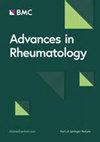与骨赘患者骨侵蚀相关的临床特征和风险因素
IF 2
4区 医学
Q3 RHEUMATOLOGY
引用次数: 0
摘要
如果关节腔内长期沉积大量尿酸盐结晶,就会出现骨侵蚀,并逐渐导致骨骼肌坏死和关节畸形。本研究旨在描述患有骨赘的痛风患者的临床特征以及与骨侵蚀相关的因素。研究共招募了210名患有骨赘的痛风患者,并将其分为骨侵蚀组(135人)和非骨侵蚀组(75人)。采用数字射线摄影术(DR)检测肘关节、腕关节、膝关节、踝关节、指间关节和跖趾关节的骨侵蚀情况。记录并比较两组患者的临床特征。为探讨与骨侵蚀相关的因素,进行了多变量逻辑回归分析。与非骨侵蚀组相比,骨侵蚀组患者年龄较大,痛风和趾骨病程较长,血清肌酐(sCr)水平较高,饮酒史和溃疡比例较高,肾小球滤过率(GFR)较低。单变量逻辑回归分析结果显示,性别、年龄、体重指数(BMI)、痛风持续时间、趾瘤持续时间、GFR、白细胞(WBC)计数、sCr 水平、吸烟史、饮酒史和是否存在溃疡与骨质破坏有关。多变量逻辑回归分析结果表明,牙周病病程、饮酒史、溃疡和 sCr 与骨侵蚀呈独立的正相关。伴有骨侵蚀的 Tophi 患者具有不同的临床特征。骨质疏松症患者的骨质疏松症持续时间、饮酒史、溃疡和 sCr 与骨侵蚀有关。本文章由计算机程序翻译,如有差异,请以英文原文为准。
Clinical characteristics and risk factors associated with bone erosion in patients with tophi
If a large amount of urate crystals is deposited in a joint cavity for an extended period of time, bone erosion will occur and gradually cause skeletal muscle necrosis and joint deformity. The aim of this study was to describe the clinical characteristics and factors associated with bone erosion in gout patients with tophi. A total of 210 gout patients with tophi were enrolled and divided into a bone erosion group (n = 135) and a non-bone erosion group (n = 75). Digital radiography (DR) was performed to detect bone erosion in the elbow, wrist, knee, ankle joints, interphalangeal and metatarsophalangeal joints. The clinical characteristics were recorded and compared between the two groups. Multivariate logistic regression analysis was conducted to explore the factors associated with bone erosion. Compared with the non-bone erosion group, the bone erosion group had an older age, longer disease duration of gout and tophi, higher level of serum creatinine (sCr), higher proportion of drinking history and ulceration, and a lower glomerular filtration rate (GFR). Univariate logistic regression analysis results showed that sex, age, body mass index (BMI), gout duration, tophi duration, GFR, white blood cell (WBC) count, sCr level, smoking history, drinking history, and presence of ulceration were associated with bone destruction. Multivariable logistic regression analysis results indicated that tophi duration, drinking history, ulceration and sCr were positively and independently related to bone erosion. Tophi patients with bone erosion presented different clinical characteristics. Tophi duration, drinking history, ulceration and sCr were associated with bone erosion in gout patients with tophi.
求助全文
通过发布文献求助,成功后即可免费获取论文全文。
去求助
来源期刊

Advances in Rheumatology
Medicine-Rheumatology
CiteScore
4.00
自引率
4.30%
发文量
41
审稿时长
53 weeks
期刊介绍:
Formerly named Revista Brasileira de Reumatologia, the journal is celebrating its 60th year of publication.
Advances in Rheumatology is an international, open access journal publishing pre-clinical, translational and clinical studies on all aspects of paediatric and adult rheumatic diseases, including degenerative, inflammatory and autoimmune conditions. The journal is the official publication of the Brazilian Society of Rheumatology and welcomes original research (including systematic reviews and meta-analyses), literature reviews, guidelines and letters arising from published material.
 求助内容:
求助内容: 应助结果提醒方式:
应助结果提醒方式:


